Patagonia SnowDrifter Bibs
Reviewer: 5’10”, 145 Ibs
Size Tested: Medium
Blister’s Measured Weight (size Medium): 607.7 grams
Fabric: 3-layer H2No Standard Performance Shell w/ 5-oz, 75-denier 100% polyester (70% recycled) stretch ripstop face fabric with a DWR finish and soft knit backer
Stated Features:
- Light and stretchy 3L fabric and minimalist design
- Suspenders detach in front for quick and easy entry
- Full coverage bibs have a drop seat configuration with two-way slider side zips for venting and convenient relief
- Boot gaiters seal out snow; tough scuff guards protect inside of legs and bottom hem
- Concealed RECCO reflector
Pockets:
- 1 exterior kangaroo pocket on bib (zippered)
- 2 exterior thigh pockets (zippered)
MSRP: $349
Test Locations: Crested Butte, Summit County, Front Range, & Telluride; CO
Days Tested: ~10
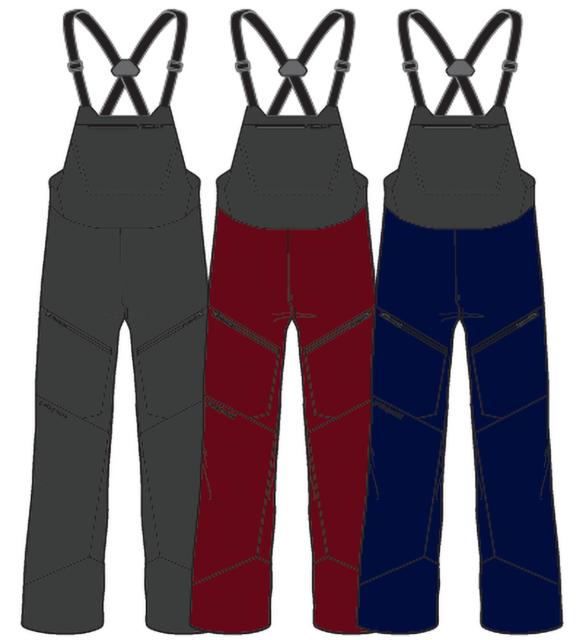
Intro
The Patagonia Descensionist Jacket and Pants were a favorite here at Blister, earning a “Best Of” award from both our male and female reviewers. So to say that the new SnowDrifter Jacket & Bibs — which replace the Descensionist series for 19/20 — have big shoes to fill might be a bit of an understatement.
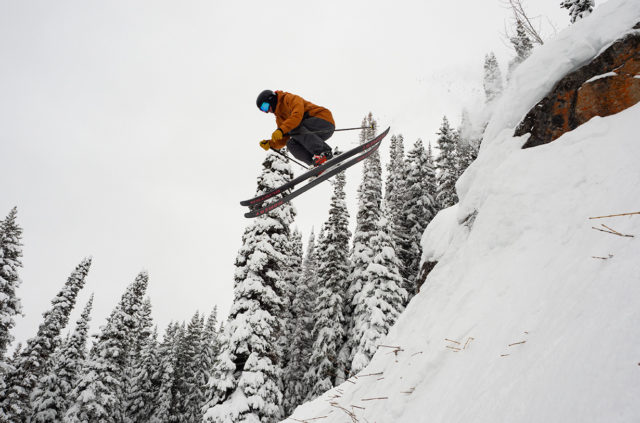
I’ve now used the SnowDrifter Bibs in a variety of conditions, both in the resort and on the skin track, and I think the new bibs are a solid offering. And, for some people at least, they might even work better than the Descensionist Pants that they effectively replace.
Fit
Similar to the Descensionist Pants, the SnowDrifter Bibs have a baggier, “freeride” cut. The size Medium has plenty of room in the waist and seat for my 5’10”, 140 lbs frame. Granted, my 29” waist doesn’t do much to test the girth of most Medium pants, but the SnowDrifter has a lot of room in the seat. The bibs also fit with plenty of room to spare over all of my alpine and AT ski boots. The fit of the SnowDrifter is a hair slimmer than the Flylow Baker Bib, but certainly baggier than most of the ski pants I’ve used.
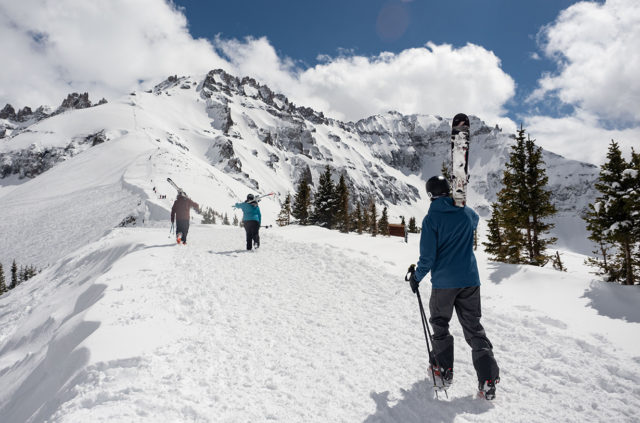
In contrast to its baggy lower fit, the bib section of the SnowDrifter Bibs fits rather snug. I appreciate this because it makes for easier layering as there’s less fabric to bunch up under my upper layers. Plus, the softshell fabric used on the upper bib section is very comfortable and stretchy so I don’t have any comfort issues with the fit of the bib.
The fit of the SnowDrifter Bibs certainly falls on the more generous end of the spectrum. If I was using the SnowDrifter exclusively as an inbounds pant, I would have no qualms with the fit. For touring, I would prefer to have a slightly slimmer fit in the leg (mostly to decrease the amount of fabric that could snag on stuff while skinning and bootpacking).
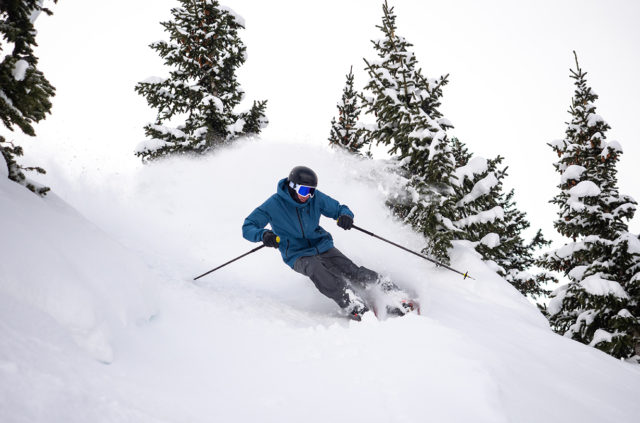
I think the SnowDrifter Bibs’ fit makes a lot of sense for its intended use. As I’ll dive into below, I think the SnowDrifter Bibs make the most sense as a resort or 50/50 bib that you’d use for some touring. And as always, fit comes down to personal preference. So I’m sure that there are people out there who will get along well with the SnowDrifter Bib’s roomier cut, even for touring.
Features
The SnowDrifter Bibs are fairly barebones on features, which is something I personally appreciate. The bibs have two thigh pockets, one kangaroo pocket on the bib, a drop seat (the ~40.5cm zippers double as leg vents), a simple suspender system, and fixed snow gaiters at the cuffs.
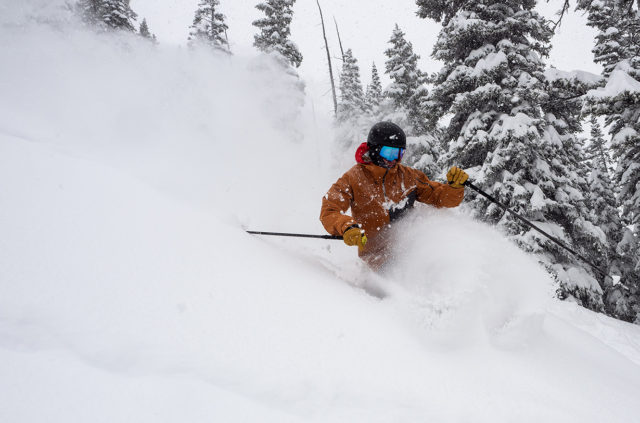
The feature set on the SnowDrifter feels more like that of a minimal touring pant than that of a resort pant. However, the minimal feature set (fewer pockets, zippers, vents, etc) is one of the big contributing factors in the exceptional comfort of this bib. The clean silhouette (combined with the extremely supple fabric, which I’ll talk about later) keep this pant very comfortable and make it one of the few hardshell pants I’ve used that I’m happy to wear without long underwear bottoms underneath.
Weight
Due to its heavier face fabric and the addition of the upper bib, the SnowDrifter Bibs come in over 100 grams heavier than the Descensionist Pants. At about 600 grams, the SnowDrifter is still reasonably light for touring, but it is on the heavier end of the spectrum.
For reference, here are a number of our measured weights for some notable 3L ski pants in this category. Note the size differences to keep things apples-to-apples.
441 g Norrona Lyngen Windstopper Hybrid Pants, size Large
485 g Strafe Cham Pants, size Large
494 g Patagonia Descensionist Pants, size Medium
539 g Arc’teryx Rush LT Pant, size Medium
555 g Open Wear Open One 3L Shell Pants, size Medium
603 g Patagonia PowSlayer Bibs, size Large
608 g Patagonia SnowDrifter Bibs, size Medium
618 g Rab Sharp Edge Pants, size Medium
620 g Arc’teryx Sabre Pants, size Large
896 g Flylow Baker Bib, size Small
Materials
There are two main materials on the SnowDrifter Bibs — a new proprietary 3L waterproof / breathable laminate that makes up most of the pant and a stretchy soft shell that makes up the bib.
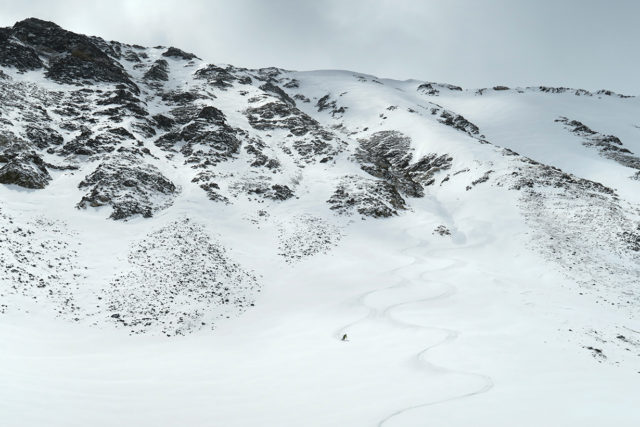
Patagonia’s new 3L H2No fabric used in the SnowDrifter is incredibly comfortable. It’s the main reason we all got extremely excited about the SnowDrifter at Outdoor Retailer this year — the hand feel on the fabric is incredible.
In the mountains, the fabric is equally impressive as it was at the trade show. The SnowDrifter’s fabric has a fully protective 3L laminate, but it feels softer than even some of the softshells I’ve used. The SnowDrifter’s fabric is pretty stretchy and the liner material is very soft on the skin. With the exception of the freakishly soft Rab Kinetic Plus (which Rab markets as a softshell, but that has a 10K-rated membrane), the SnowDrifter has the softest and most comfortable fabric of any waterproof shell I’ve used.
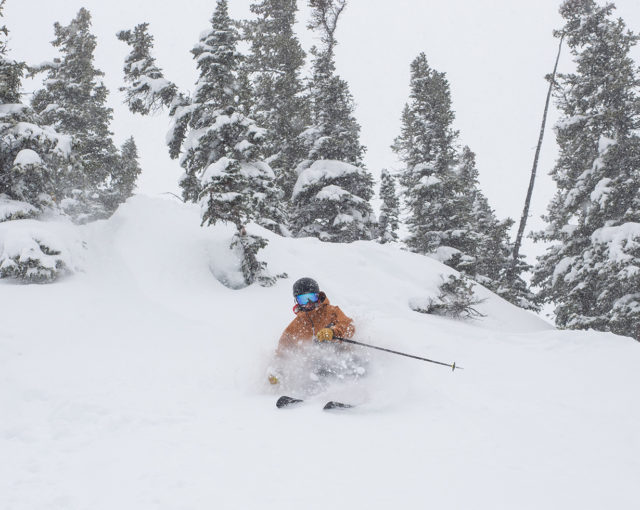
The Snowdrifter’s fabric has also proven to be quite hard wearing, especially given how soft it feels. After about 10 days in the bibs, there are certainly scuffs and scratches on the main fabric from ski edges, but in general, I’m very happy with how the pants are holding up. And the reinforced fabric around the cuffs, which is much burlier than the bibs’ main fabric, also looks almost new.
The stretchy softshell upper on the SnowDrifter Bibs is quite comfortable and breathable — which is nice because it does fit somewhat snuggly around my chest (depending on how I have the suspenders adjusted). The use of a membrane-less material on the upper bib also helps the SnowDrifter Bibs feel more breathable in the torso compared to other bibs with fully waterproof fabrics used throughout.
Weather Resistance
Though Patagonia doesn’t publish waterproof / breathability ratings (which can be misleading and / or unreliable), we’ve been told that the SnowDrifter’s fabric is spec’d somewhere around 20K/20K — which would place it firmly in the “hardshell” category of protection (as opposed to less protective softshells).
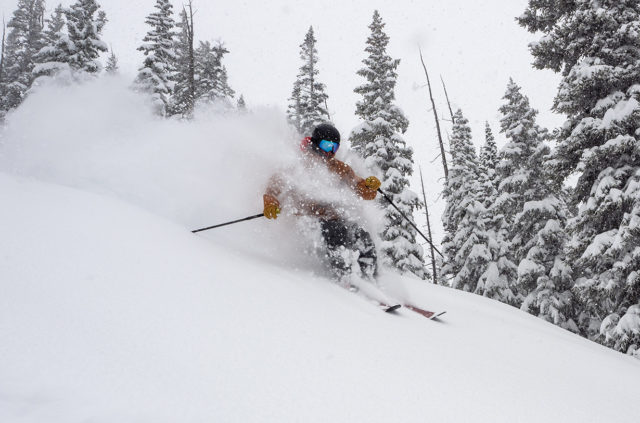
In my experience with the SnowDrifter Bibs, I would say that they offer true hardshell performance when it comes to weather resistance. After using the bibs in several wet spring storms, I haven’t experienced any moisture soaking through the membrane.
As seems to be the case with most shells that use soft face fabrics, I have experienced a bit more wetting out of the face fabric than I would expect on stiffer hardshell fabrics with tighter weaves. But I still haven’t had any water get all the way through the fabric of the SnowDrifter. It’s also important to note that the pre-production pair of the SnowDrifter Bibs that I’ve been using featured an experimental DWR. The production version of the SnowDrifter kit will use Patagonia’s standard DWR treatment which has performed excellently on other pieces we’ve used from them. Apart from the DWR, everything else on the SnowDrifter kit we’ve been testing is the same as the production version that will be available this fall.
Breathability
One of the most notable differences between the Descensionist and the SnowDrifter is the difference in breathability between the two fabrics. The SnowDrifter is significantly more protective than the Descensionist and, probably consequentially, significantly less breathable.
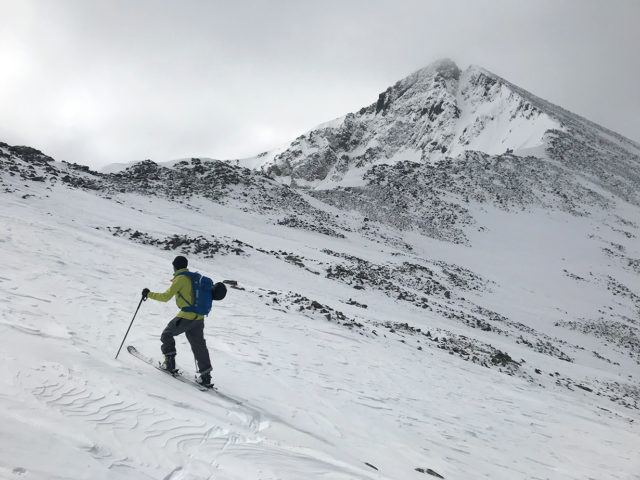
The Descensionist used one of the most breathable 3L fabrics we’ve ever tested. It was so breathable that it felt distinctly colder than more traditional hardshells, particularly in the wind. The SnowDrifter feels much more like most other hardshells when it comes to breathability and I’ve found it to be generally more comfortable in terms of temperature regulation — especially in the resort where my output is lower and I sweat much less.
On the skin track, I’ve been happy touring in the SnowDrifter. It’s baggier cut and large leg vents (16” / 40.5 cm) mean that the pant can keep up with my output on all but the warmest or fastest days in the mountains. All that said, if the thing you loved most about the Descensionist was how breathable its fabric was, take note that the SnowDrifter is not as breathable.
Compared to a few other hardhshell pants I’ve worn this season, the SnowDrifter is probably a touch more breathable than the Flylow Baker Bib and Rab Sharp Edge Pant, and not quite as breathable as the Gore-Tex C-Knit fabric on the old Mammut Alvier HS pants.
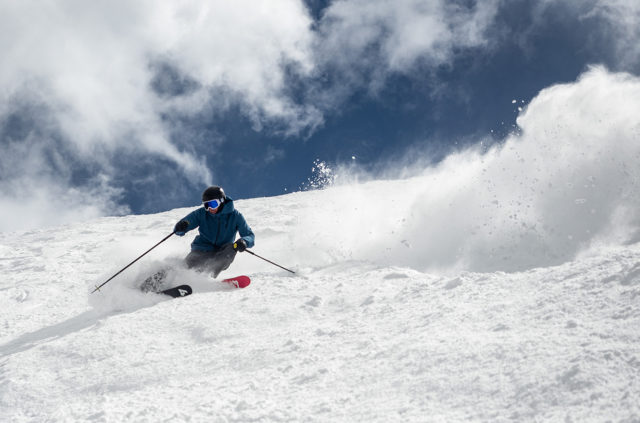
All in all, the breathability of the SnowDrifter kit is good compared to other high-end, 3L waterproof / breathable shells. It doesn’t stand out as much as the Descensionist did in this regard, but for people who thought the Descensionist was too cold or not protective enough, the SnowDrifter is worth a good look.
Warmth
The SnowDrifter is a 3L hardshell with no added insulation. It is not a very warm pant. In the category of hardshell pants though, the SnowDrifter is one of the warmer ones I’ve worn. I’m happy wearing the SnowDrifter Bibs without long-underwear bottoms for many days inbounds and for most days of touring. Granted, I do tend to run a bit warm in my legs, so if you tend to run cold and / or need to layer under your other shell pants, expect to need to do so in the SnowDrifter Bibs.
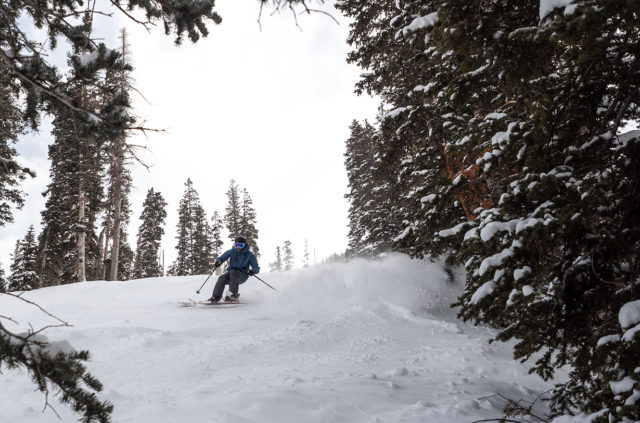
As I noted above, the SnowDrifter is significantly warmer than the Descensionist that it replaces.
Durability
I’m pretty happy with how the SnowDrifter Bibs are holding up. For a pant this soft and comfortable, it’s impressive that I haven’t noticed any durability issues after around 10 days of hard use. I highly doubt that the SnowDrifter will be as durable as something like the Flylow Baker Bib, which uses much heavier and stiffer fabrics. But for the super supple fabric that the Snowdrifter uses, I’ve been pleased with its durability. Of course, I’ll update this review if anything changes on that front.
Price
Many modern, high-end 3L shells are very expensive. While the SnowDrifter Bibs are far from the cheapest pants out there at $349, they are significantly cheaper than many of the pieces in this category that match their performance. And we think that’s worth highlighting.
Who’s It For?
The SnowDrifter Bibs are an excellent option for people who want a high-performance pant for inbounds or 50/50 use and who prioritize comfort over maximum durability, breathability, or protection. Given that the SnowDrifter Bibs are still quite good when it comes to durability, breathability, and weather protection, I think a lot of skiers and snowboarders could get along well with them.
If you want a dedicated touring pant, I’d probably recommend going with something lighter, more breathable, and a bit slimmer fitting. Though, if you like touring pants with baggier cuts, the SnowDrifter is still a very viable option. Conversely, if you want a super burly inbounds pant, there are heavier, more durable options (e.g., Flylow Baker Bib). But for most skiers and snowboarders, the SnowDrifter Bib is an exceptionally comfortable, fully protective hardshell pant that feels at home in most scenarios.
Bottom Line
The Patagonia SnowDrifter Bibs replace a well-loved piece, but the new bibs are arguably even more versatile for a wider range of users. The SnowDrifter Bibs are more comfortable and more protective than the Descensionist and have a clean and versatile silhouette and feature set. Thanks to the SnowDrifter Bibs’ excellent all-round performance in a wide variety of conditions and their more moderate price point, we think a lot of skiers and snowboarders will get along well with the SnowDrifter Bibs.

Sam,
I’m really looking forward to the new SnowDrifter jacket review but this is review is a great preview given I’m assuming they are made from the same material. I’m just wondering how the Patagonia 3L membrane and face material in the SnowDrifter compares in various NeoShell products in terms of waterproofness, breathability, and feel.
Thanks
Sorry about the typo … that should be
compares TO various NeoShell products
Hey Alexander,
You’re right to assume that the bib uses the same fabric as the jacket, I’ll have the jacket review out soon, I just need a few more days in it.
As far as the NeoShell comparison, I would say that the fabric on the SnowDrifter is more protective and less breathable than NeoShell. The old Descensionist falls on the other side of NeoShell for reference — it’s less protective and more breathable. As far as hand feel goes, that’s a bit hard to say as there are many different layups of NeoShell on the market. I would say on the whole though, that the hand on the SnowDrifter is softer than the majority (if not all) NeoShell pieces I’ve used. The SnowDrifter’s fabric is also a bit thicker than most NeoShell pieces, so it tends to have a bit more structure, which I really appreciate.
I hope that answers your questions!
Sam
Is it just me or do I see a couple of pictures of you guys wearing black diamond gear? I’m curious about their mission shell, looking forward to those reviews!
Hey Mono, I’ve been wearing the Mission Shell a bit this spring and so far, I like it a lot. Look out for a full review in the next few weeks!
For your future outerwear review articles please add couple of simple stature pictures of the person showing off in the pants/jacket.
By “simple” and “showing off” I mean not in the middle of the turn in knee deep powder from 100m distance, as usual.
A picture is worth a thousand words, esp. when talking about pant’s fit.
Thanks for review anyway!
Great review! Any plans to cover the new Flylow Smythe bib?
Hi Sam
Great read as always ! I ski in the french alps, bit of a gear junkie too and I am a great fan of patagonia clothes. I have been wearing them over the years for resort skiing and freeriding above in the backcountry. For the past two years I have been skiing with the powder bowl insulated jacket and pants which I found quite restistant from the weather but a bit heavy and eventually warm. I am looking forward to start touring this year and I am keen to buy this year (I have return lots of old stuff to them for recycling, like the first version of the triolet shell when it was made in the US, and they just gave me a great coupon to use on the new season coming products). Question is rather simple : considering I’ll be more into something like 30% resort sking, 30% freeriding and 30% touring (eventually), shall I buy the descensionist kit right now that they are still available, or wait until the snowdrifter jacket and bib which seem to be a bit burlier and more weather proof. I am a big guy, 190cm and 100kgs, on the aggressive side ski wise. Thank you for your feedback !
I would definitely go with the Snow Drifter if you’re only touring 30% and are happy with your Powder Bowl kit. It is definitely a bit more burly than the Descensionist and offers more protection for your resort/freeride days. The Descensionist is a great kit but the primary benefit is the very good breathability, which, most of the time, you won’t be needing.
Hope that helps!
Sam
That’s what I thought, thank you Sam. I find the powder bowl stuff too burly and the pow slayer too noisy so the snowdrifter looks like the way to go !
I have the Powslayer bibs for resort/storm days, but have been looking for a good pair of touring pants. There are still some of the Descensionist pants out there on sale but am curious if these bibs are better. I want something more touring specific but that could also be versatile for hut trips, etc. Which of the two would you recommend? Thanks!
Hi Sam !
Eventually I decided to go with the descensionist jacket as there were so many good reviews and the price was very low. Snow drifter jacket seems too little of an update from it to buy it so I will only buy the bib which I need. As for midlayers, since you seem to be quite experienced in Patagonia’s offering what would you recommand for cold early winter inbounds days ? I already own a micropuff which is awesome, that I usually pair with some MW capilene on most days. To complement the jacket which as you said isn’t the most weather resistant shell, shall I add the macro puff (after trying it on it seemed to be a pretty good cold waether mid layer for skiing) or just a techface R1 hoody I could just throw in the mix when needed ? I usually don’t get too cold but I too feel the micro puff and the jacket alone might not be enough for a full winter in the alps. Thank you for your insight !
How do these compare to a pair for 2L or 3L goretex Patagonia pant?
What do you recommend for someone debating between these and powslayer bib? I have the pow slayer jacket and love it
What would you prefer between this and the Pow Slayer bib for 70% resort 30% touring?
Hey, I’m late to the game here but I just got these bibs. I’m 140lb and 5’9”. Reading your review, I just kept thinking, “why didn’t he get the small?”
Based on your review, I got the small and I don’t really have the baggy issues that you mentioned. Plenty of length even if I were a bit taller.
Definitely a ski pant, if I were to use these ice climbing, I’d need to add a tight fitting gaiter or something similar.
Since the companies are closing these out right now, maybe someone will benefit from those details